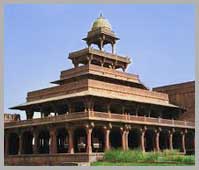
Agra Tourism Attractions
Agra Fort Buland Darwaza Chini - Ka - Rauza Dayal Bagh Temple Fatehpur Sikri Itmad-ud-daulah Mariyam Tomb Mumtaz Mahal Ram Bagh Shopping & Cuisine Sikandra The Taj Mahal Taj Mahotsav The Octagonal TowerFatehpur Sikri

Fatehpur Sikri is the other popular attraction in Agra built in the second half of the 16th century by the Emperor Akbar. Fatehpur Sikri means “The City of Victory” that was the capital of the Mughal Empire for around 10 years. This city was built in honour of Sufi saint Sheikh Salim Chisti who lived in a natural enclosure on the ridge at Sikri who predicted the birth of Akbar’s son, Jahangir.
This fort comes renowned for the different palatial buildings, royal palaces and courts. The amalgamation of Indian, Persian and Islamic architecture bring to this fort an impressive one which was declared an UNESCO World Heritage Site in 1986.
Here, some of the famous architectural buildings of this fort are:
Diwani-e-Aam
Diwani-e-Aam (Hall of Public Audience) is the place, where the emperor with his officials heard the petitions of public. The hall is famous for its paved courtyard known as the Pachisi. It was, where the ruler played chaubar, a game that closely fits equal to chess using slave girls as pieces.
Diwani-e-Khaas
This is the >Hall of Private Audience, where the emperor debated diverse issues with noted theologists. The hall was used for the private meetings by emperors, where he discussed issues related to his governance. This is a plain square building with four chhatris on the roof. The central pillar has a square base and an octagonal shaft carved with bands of geometric and floral designs and the thirty-six serpentine brackets support a circular platform are the foremost attraction of this building.
Buland Darwaza
This 54 meter tall large piece of architecture is the largest of gateways in the world. This is the triumphal arch commissioned by the Mughal Emperor Akbar, when he overwhelmed the king of Khandesh or Gujarat in 1573. This gate is made up of red sandstone and engraved with Quranic verses, calligraphic and cenotaph.
Palace of Jodha Bai
This is the grandest of all palaces in Fatehpur Sikri dedicated to Akbar's wife Jodha Bai. The architecture of this building is a mixture of styles with Hindu columns and Muslim cupolas. This palace is the largest and the most important part of the royal harem.

Panch Mahal
This is a five-storied pavilion of winds in decreasing order. Fatehpur Sikri is the other popular attraction in Agra built in the second half of the 16th century by the Emperor Akbar. Fatehpur Sikri means “the City of Victory” that was the capital of the Mughal Empire for around 10 years. This city was built in honour of Sufi saint Shaikh Salim Chisti who lived in a natural enclosure on the ridge at Sikri who predicted the birth of Akbar’s son the Jahangir.
Tomb of Sheikh Salim Chisti
This is a marvel tomb inside the Fatehpur Sikri built by Mughal Emperor Akbar in honour of the Saint Sheikh Salim Chisti whose blessings gave him three sons. The tomb is single-storey structure built around a central square chamber famous for ornate wooden canopy encrusted with mother-of-pearl mosaic.
Naubat Khana
Naubat Khana is known as Naqqar Khana that means a drum house, where a musician used drums to declare the arrival of the Emperor. This is situated ahead of the Hathi Pol Gate or the Elephant Gate, the south entrance to the complex.
Jami Masjid
This is a Jami Mosque meaning the Friday Mosque. Jami Masjid was built in 1571 AD. It is known for the row of chhatri on top of the building. There are three mihrabs in each of the seven bays, while the galactic central mihrab gets covered by a dome decorated with white inlay in geometric patterns.
Anup Talao
Anup Talao is as an ornamental pool with a central platform and four bridges leading up to it. Some of the important buildings to the royal district bear this pool are Khwabgah, Panch Mahal, Diwan-i-Khas and Ankh Michauli.
Timing
This opens on all days from sunrise to sunset.
Entry Fees
Foreigners: Rs 485/-
Indians: INR Rs 50/-
Address to Predictor of Jehangir's Birth.
